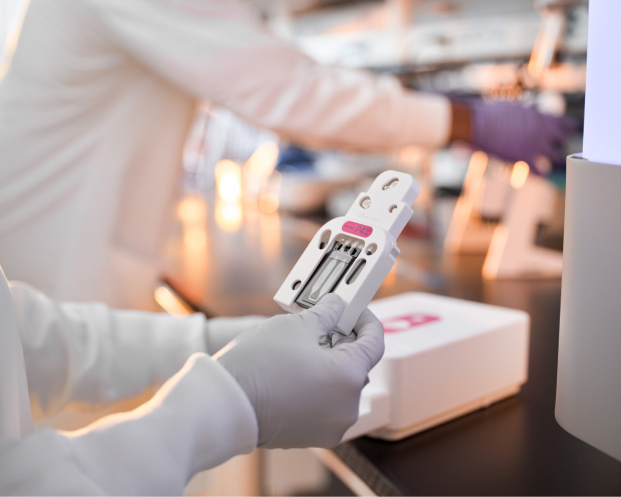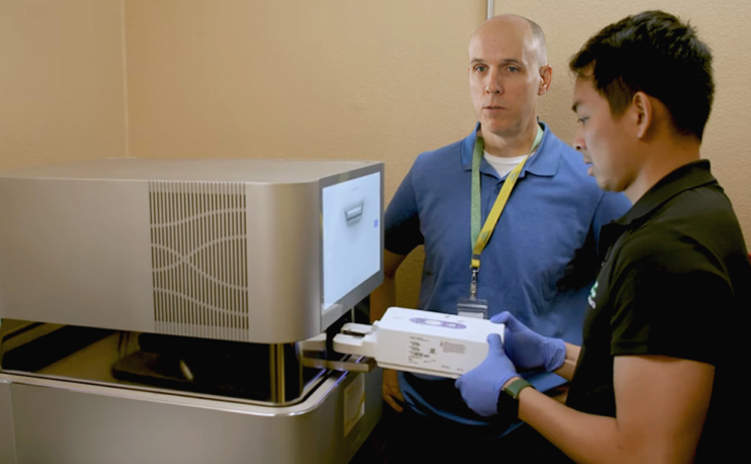Sequencing only the coding regions of the genome enables researchers to focus on the genes most likely to affect phenotype, and offers an accessible combination of turnaround time and price.
NextSeq 1000 and NextSeq 2000 System applications and methods
Flexibility to do more
Fuel a broad range of applications, from targeted panels to whole-genome sequencing and more

Key applications and methods
Library prep
Illumina DNA Prep with Enrichment + Illumina Exome Panel
A fast, integrated whole-exome enrichment and sequencing library preparation workflow for a wide range of applications.
Sequencing
NextSeq 1000/2000 XLEAP-SBS reagent kits
NextSeq 1000/2000 XLEAP-SBS reagent kits contain a reagent cartridge, flow cell, and resuspension buffer. Multiple flow cell configurations offer adjustable output based on project needs.
Data Analysis
Push-button alignment, followed by variant calling of Illumina exomes to rapidly identify disease-associated variants.
mRNA-Seq detects known and novel transcripts and measures transcript abundance for accurate, comprehensive expression profiling.
Library prep
A simple, scalable, cost-effective, rapid single-day solution for analyzing the coding transcriptome leveraging as little as 25 ng input of standard (non-degraded) RNA.
Sequence
NextSeq 1000/2000 XLEAP-SBS reagent kits
NextSeq 1000/2000 XLEAP-SBS reagent kits contain a reagent cartridge, flow cell, and resuspension buffer. Multiple flow cell configurations offer adjustable output based on project needs.
Analyze
Perform alignment, quantification, and fusion detection.
Assess the individual contributions of single cells in complex tissues by profiling the transcriptome.
Library prep
10x Genomics Chromium Single Cell Gene Expression provides single cell transcriptome 3' gene expression and multiomic capabilities to profile tens of thousands of cells. Explore cellular heterogeneity, novel targets, and biomarkers with combined gene expression, surface protein expression, or CRISPR edits in each cell.
Sequence
NextSeq 1000/2000 XLEAP-SBS reagent kits
NextSeq 1000/2000 XLEAP-SBS reagent kits contain a reagent cartridge, flow cell, and resuspension buffer. Multiple flow cell configurations offer adjustable output based on project needs.
Analyze
DRAGEN Single-Cell RNA Pipeline
This integrated pipeline goes from base calls to a cell-by-gene-expression matrix with a single user touchpoint, compatible with a variety of third-party sample preparation kits. Available on the NextSeq 2000 System as well as on the DRAGEN Server.
Multiomics multiplies your discovery power
The P3 and P4 flow cells on the NextSeq 2000 System are an excellent fit for multiomics studies. Use multiomics to better connect genotype to phenotype and obtain a full cellular readout not found through single-application approaches.
More applications and methods
Spatial transcriptomics
Detect transcriptional activity to resolve mRNA expression at the cellular level in structurally preserved tissues.
Total RNA sequencing
Analyze coding plus multiple forms of noncoding RNA for a comprehensive picture of the transcriptome.
Immune repertoire analysis
Identify unique receptor variants to map the vast repertoire of immune cells capable of recognizing a seemingly boundless array of targets.
Small whole-genome sequencing
Sequence the entire genome of a bacterium, virus, or other microbe for applications in public health, infectious disease surveillance, molecular epidemiology studies, and environmental metagenomics.
Target enrichment
Use sequence-specific hybridization to analyze genomic regions of interest.
Targeted RNA sequencing
Select and sequence specific transcripts of interest for gene expression profiling studies.
Hear from fellow researchers
Hear how the NextSeq 2000 provides scientists with the precision, affordability, and accessibility to make their research a reality.
NextSeq 2000: A range of applications
Learn how the NextSeq 2000 system delivers the flexibility to support your research needs including bulk RNA-Seq, target enrichment, single-cell RNA-Seq, and much more.
